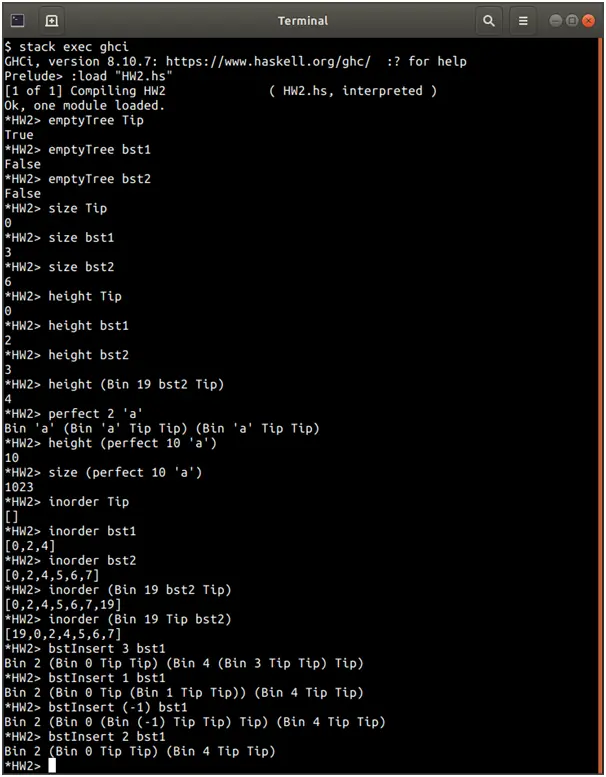Instructions
Objective
Write a haskell assignment program to Manipulate binary trees.
Requirements and Specifications
Given a binary search tree t, bstInsert x t is a binary search tree formed by
-- replacing a Tip in t with (Bin x Tip Tip) or t, if t already contains x.
--
-- *HW2> bstInsert 3 bst1
-- Bin 2 (Bin 0 Tip Tip) (Bin 4 (Bin 3 Tip Tip) Tip)
-- *HW2> bstInsert 1 bst1
-- Bin 2 (Bin 0 Tip (Bin 1 Tip Tip)) (Bin 4 Tip Tip)
-- *HW2> bstInsert (-1) bst1
-- Bin 2 (Bin 0 (Bin (-1) Tip Tip) Tip) (Bin 4 Tip Tip)
-- *HW2> bstInsert 2 bst1
-- Bin 2 (Bin 0 Tip Tip) (Bin 4 Tip Tip)
--
-- Note: bstInsert should assume that the tree is a valid binary search tree, meaning
-- that the root is greater than all elements in its left subtree and less than all
-- elements in its right subtree. If bstInsert is given a binary search tree, its output
-- must also be a binary search tree. If bstInsert is given a tree that is not a binary
-- search tree, any convenient output is acceptable.
bstInsert :: Ord a => a -> Tree a -> Tree a
bstInsert = undefined
Screenshots of output

Source Code
module HW2 where
data List a
= Nil
| Cons a (List a)
deriving (Show, Eq, Ord)
data Tree a
= Tip
| Bin a (Tree a) (Tree a)
deriving (Show, Eq, Ord)
bst1 =
Bin 2
(Bin 0 Tip Tip)
(Bin 4 Tip Tip)
bst2 =
Bin 5
bst1
(Bin 7
(Bin 6 Tip Tip)
Tip)
-- 0. emptyTree t returns True if and only if its argument is Tip
emptyTree :: Tree a -> Bool
emptyTree Tip = True
emptyTree _ = False
-- As with HW1, replace each incorrect definition with a correct definition. For example,
--
-- emptyTree Tip = True
-- emptyTree _ = False
-- 1. size t returns the total number of elements in t. This is the same as the number of
-- Bin nodes in t.
--
-- *HW2> size bst1
-- 3
-- *HW2> size bst2
-- 6
size :: Tree a -> Int
size Tip = 0
size (Bin _ lt rt) = size lt + size rt + 1
-- 2. height t returns the height of t. This is the length of the longest path from the
-- root node to a Tip.
--
-- *HW2> height Tip
-- 0
-- *HW2> height bst1
-- 2
-- *HW2> height bst2
-- 3
-- *HW2> height (Bin 19 bst2 Tip)
-- 4
height :: Tree a -> Int
height Tip = 0
height (Bin _ lt rt) = max (height lt) (height rt) + 1
-- 3. perfect n a returns a "perfect" binary tree of height n containing the value
-- a for all nodes. In a perfect binary tree, all nodes have either two children
-- or no children.
--
-- *HW2> perfect 2 'a'
-- Bin 'a' (Bin 'a' Tip Tip) (Bin 'a' Tip Tip)
--
-- In general, we expect the following rules to hold:
-- for all positive integers n and all arbitrary values x:
-- height (perfect n x) == n
-- size (perfect n x) == 2^n - 1
perfect :: Int -> a -> Tree a
perfect 0 _ = Tip
perfect 1 x = Bin x Tip Tip
perfect n x = Bin x (perfect (n - 1) x) (perfect (n - 1) x)
-- 4. inorder t returns a list containing all the elements of t in order, meaning the
-- elements of the left subtree (in order), followed by the root, followed by the
-- elements of the right subtree (in order).
--
-- *HW2> inorder Tip
-- []
-- *HW2> inorder bst1
-- [0,2,4]
-- *HW2> inorder bst2
-- [0,2,4,5,6,7]
-- *HW2> inorder (Bin 19 bst2 Tip)
-- [0,2,4,5,6,7,19]
-- *HW2> inorder (Bin 19 Tip bst2)
-- [19,0,2,4,5,6,7]
--
-- In general, for all binary trees t, we expect
-- length (inorder t) == size t
--
-- Note: the order in "inorder" is the order of items in the tree, not their sorted
-- order. Your implementation should not perform any comparisons.
inorder :: Tree a -> [a]
inorder Tip = []
-- if tree, get inorder list from left, append to root element and then append
-- to right inorder list
inorder (Bin x lt rt) = inorder lt ++ [x] ++ inorder rt
-- 5. Given a binary search tree t, bstInsert x t is a binary search tree formed by
-- replacing a Tip in t with (Bin x Tip Tip) or t, if t already contains x.
--
-- *HW2> bstInsert 3 bst1
-- Bin 2 (Bin 0 Tip Tip) (Bin 4 (Bin 3 Tip Tip) Tip)
-- *HW2> bstInsert 1 bst1
-- Bin 2 (Bin 0 Tip (Bin 1 Tip Tip)) (Bin 4 Tip Tip)
-- *HW2> bstInsert (-1) bst1
-- Bin 2 (Bin 0 (Bin (-1) Tip Tip) Tip) (Bin 4 Tip Tip)
-- *HW2> bstInsert 2 bst1
-- Bin 2 (Bin 0 Tip Tip) (Bin 4 Tip Tip)
--
-- Note: bstInsert should assume that the tree is a valid binary search tree, meaning
-- that the root is greater than all elements in its left subtree and less than all
-- elements in its right subtree. If bstInsert is given a binary search tree, its output
-- must also be a binary search tree. If bstInsert is given a tree that is not a binary
-- search tree, any convenient output is acceptable.
bstInsert :: Ord a => a -> Tree a -> Tree a
bstInsert x Tip = Bin x Tip Tip
bstInsert x (Bin y lt rt) =
-- if equal to the value, return the tree
if x == y then (Bin x lt rt)
-- if smaller than value in root, recurse to insert at left subtree
else if x < y then Bin y (bstInsert x lt) rt
-- else, it's greated than value in root, recurse to insert at right subtree
else Bin y lt (bstInsert x rt)
Related Samples
Check out our free Haskell assignment samples to enhance your understanding of this functional programming language. Our examples provide detailed solutions and insights, helping you grasp complex concepts and improve your skills effectively.
Haskell
Haskell
Haskell
Haskell
Haskell
Haskell
Haskell
Haskell
Haskell
Haskell
Haskell
Haskell
Haskell
Haskell
Haskell
Haskell
Haskell
Haskell
Haskell
Haskell
